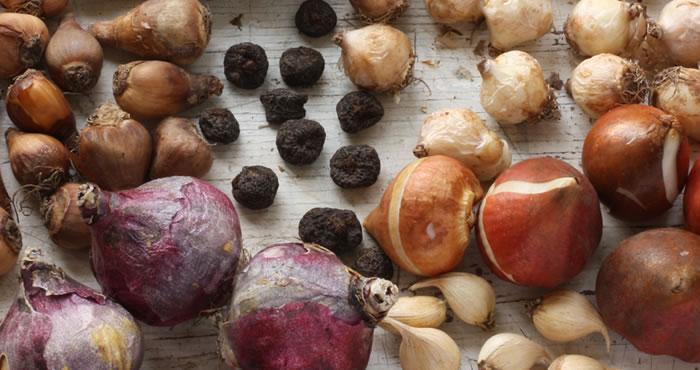When it comes to flower bulbs, size matters. The bigger the bulb, the better the bloom quality. How does this actually work, and how will you know if you are getting good quality flower bulbs? Flower bulbs are measured in centimeters around the broadest circumference of the bulb. Although inches are occasionally used as a measurement, most of the information you’ll find shows the circumference in centimeters. Although there are smaller growing operations that still sort their bulbs by hand, much better uniformity and more precise sorting is achieved by using carefully calibrated sorting machines similar to those used in grading fruit and vegetables.
Sometimes, people choose smaller bulbs
Smaller bulbs are cheaper and if you have large areas to plant up, smaller bulbs could be used. The flowers may not be all that good in the first year, but the bulbs will grow and the flower quality will improve in subsequent years. If you are considering this option, check on what you can expect: are the bulbs flowering size yet? If not, how long will it take for them to reach flowering size? On a cautionary note, some unscrupulous people get smaller bulbs, package them and sell them to gardeners or retailers at a low price. The gardener is thrilled with the windfall, but soon discovers just why the bulbs were so cheap when the flowers are disappointing or the bulbs fail to flower at all.
So what’s a good size?
As you can imagine, the quality standard you should apply to various flower bulbs depends on species, but it also depends on the variety you choose. Here are a few basic guidelines that you can apply:
Tulips
‘Landscape’ grade, or smaller bulbs should be at least 10cm in circumference. They produce relatively small blooms that are a bit bigger than a golf ball. If you choose smaller bulbs, be sure to mass plant them. For really good flowers, your tulip bulbs should be 12cm or more. This is top size, and that’s the size we ship. The larger bulb circumference produces an astounding difference. The blooms are at least as big as tennis balls and usually even larger (depending on the variety). The species type tulips are an exception to the rule and have naturally smaller bulbs and smaller blooms.
Daffodils and Narcissus
There’s a lot of variation in this group of plants. As a rule, the dwarf varieties have smaller bulbs and the big trumpet varieties are larger. Bigger is always better regardless of variety, and in general, top-grade bulbs will be 14-16cm.
Amaryllis
Amaryllis are magnificent in bloom – but only when the bulbs are big enough! You’ll get a fabulous show, bigger flowers and more blooms with bulbs 34cm or more in diameter. Needless to say, that’s our standard.
Hyacinths
These scented beauties should be at least 16m, but for pot forcing 17-19cm is better. Our bulbs are grown for quality, so you always get top grade from us.
Knowing that your bulbs are all set to burst into prize-winning bloom isn’t always a given, but with our large grade bulbs, you can be sure of success with every species and variety that you choose.
How Flower Bulbs are measured?


Meet Ben, our Flower Bulb Specialist
Gardening challenges?
- All Flower Bulbs
- All Spring Planted Bulbs
- Alliums
- Alocasia
- Amarine
- Amaryllis
- Amaryllis Belladonna
- Anemones
- Arisaema
- Artichoke Thistle
- Astilbe
- Astrantia
- Baby's Breath
- Bearded Iris
- Begonias
- Bleeding Hearts
- Calla Lilies
- Camassia
- Cardoon
- Chionodoxa
- Columbine
- Coneflower
- Convallaria
- Crocus
- Daffodils
- Dahlias
- Day Lily
- Delphiniums
- Dicentra
- Dichelostemma
- Echinacea
- Elephant Ears
- Eranthis
- Eremurus
- Eucomis
- Foxtail Lilies
- Fritillaria
- Galanthus
- Geranium
- Geum
- Giant Snowflake
- Gladiolus
- Glory of the Snow
- Gloxinia
- Grape Hyacinths
- Gypsophila
- Hellebores
- Hostas
- Hyacinthoides
- Hyacinths
- Incarvillea
- Irises
- Italian Anemones
- Italian Ranunculus
- Ixia
- Larkspurs
- Leucojum
- Lilies
- Lily of the Valley
- Masterwort
- Mixture
- Monarda
- Muscari
- Nerine
- Oriental Poppy
- Ornithogalum
- Oxalis
- Papaver
- Paperwhites
- peonies
- Phlox
- Pulmonaria
- Puschkinia
- Ranunculus
- Red Hot Poker
- Saffron Crocus
- Scilla
- Sedum
- Shamrock
- Siberian Iris
- Siberian Squill
- Snowdrops
- Spanish Bluebells
- Striped Squill
- Swamp Milkweed
- Tricyrtis (Toad Lily)
- Tuberoses
- Tulips
- Winter Aconite
- Zantedeschia
Show more
Show less